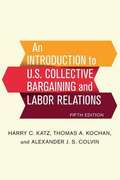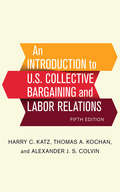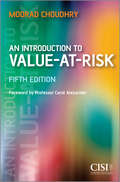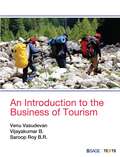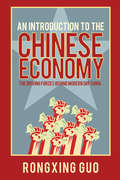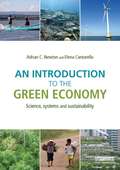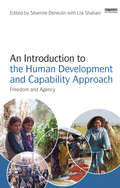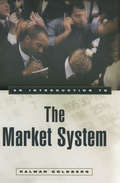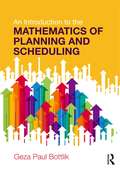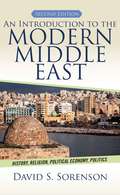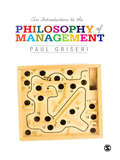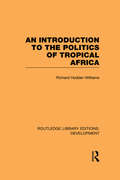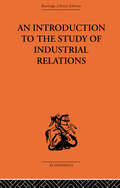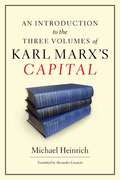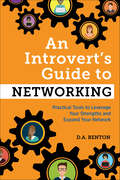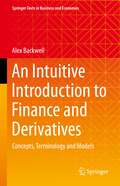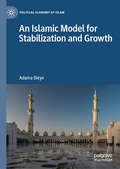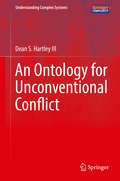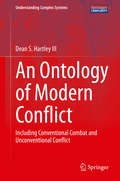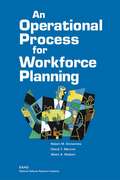- Table View
- List View
An Introduction to U. S. Collective Bargaining and Labor Relations (5th Edition)
by Thomas A. Kochan Harry C. Katz Alexander J. S. ColvinThis comprehensive textbook provides an introduction to collective bargaining and labor relations with a focus on developments in the United States. It is appropriate for students, policy analysts, and labor relations professionals including unionists, managers, and neutrals. A three-tiered strategic choice framework unifies the text, and the authors' thorough grounding in labor history and labor law assists students in learning the basics. In addition to traditional labor relations, the authors address emerging forms of collective representation and movements that address income inequality in novel ways.
An Introduction to U.S. Collective Bargaining and Labor Relations
by Thomas A. Kochan Alexander J. Colvin Harry C. KatzThis comprehensive textbook provides an introduction to collective bargaining and labor relations with a focus on developments in the United States. It is appropriate for students, policy analysts, and labor relations professionals including unionists, managers, and neutrals. A three-tiered strategic choice framework unifies the text, and the authors’ thorough grounding in labor history and labor law assists students in learning the basics. In addition to traditional labor relations, the authors address emerging forms of collective representation and movements that address income inequality in novel ways.Harry C. Katz, Thomas A. Kochan, and Alexander J. S. Colvin provide numerous contemporary illustrations of business and union strategies. They consider the processes of contract negotiation and contract administration with frequent comparisons to nonunion practices and developments, and a full chapter is devoted to special aspects of the public sector. An Introduction to U.S. Collective Bargaining and Labor Relations has an international scope, covering labor rights issues associated with the global supply chain as well as the growing influence of NGOs and cross-national unionism. The authors also compare how labor relations systems in Germany, Japan, China, India, Brazil, and South Africa compare to practices in the United States.The textbook is supplemented by a website (ilr.cornell.edu/scheinman-institute) that features an extensive Instructor’s Manual with a test bank, PowerPoint chapter outlines, mock bargaining exercises, organizing cases, grievance cases, and classroom-ready current events materials.
An Introduction to Value-at-Risk
by Carol Alexander Moorad ChoudhryThe value-at-risk measurement methodology is a widely-used tool in financial market risk management. The fifth edition of Professor Moorad Choudhry's benchmark reference text An Introduction to Value-at-Risk offers an accessible and reader-friendly look at the concept of VaR and its different estimation methods, and is aimed specifically at newcomers to the market or those unfamiliar with modern risk management practices. The author capitalises on his experience in the financial markets to present this concise yet in-depth coverage of VaR, set in the context of risk management as a whole.Topics covered include:Defining value-at-riskVariance-covariance methodologyPortfolio VaRCredit risk and credit VaRStressed VaRCritique and VaR during crisisTopics are illustrated with Bloomberg screens, worked examples and exercises. Related issues such as statistics, volatility and correlation are also introduced as necessary background for students and practitioners. This is essential reading for all those who require an introduction to financial market risk management and risk measurement techniques.Foreword by Carol Alexander, Professor of Finance, University of Sussex.
An Introduction to the Business of Tourism
by Venu Vasudevan B. VijayakumarThis textbook offers a lucid understanding of the business of tourism and helps students gain professional and entrepreneurial insights. An outcome of years of experience and practice, An Introduction to the Business of Tourism offers a fresh perspective of the skill-oriented, knowledge-based and multi-disciplinary arena of the tourism business. It presents a balanced mix of the basic principles and concepts, their application and policy implications as well as the business realities and operational aspects of the tourism industry. Divided into four sections and spread across nineteen chapters, this textbook delves deep into Indian and international tourism experiences with numerous integrated case studies and examples. Key Features: Special emphasis on recent business aspects of tourism from local and global perspectives Over 45 case studies to provide valuable insights into current business trends to strengthen the practical knowledge of students Each chapter has review questions and activities to support self-assessment. Book-end glossary of major concepts and terminologies to facilitate quick scan and easy understanding
An Introduction to the Chinese Economy: The Driving Forces Behind Modern Day China
by Rongxing GuoThis comprehensive overview of the modern Chinese economy by a noted expert from China offers a quality and breadth of coverage. In this book, the author provides an introduction to China's economy since 1949 and original insights based on his own extensive research. The book sets out to analyze and compare the operational mechanisms of the Chinese economy between the pre- and post-reform periods and through national, regional and local dimensions. Both positive and negative consequences of the Chinese economic transformation have been clarified. A multiregional comparison of the Chinese economy is conducted in terms of natural and human resources, institutional evolution, as well as economic and social performances. At last, some key issues relating to the inherent operational mechanisms of and the dynamic patterns of the Chinese economy are also discussed.
An Introduction to the Green Economy: Science, Systems and Sustainability
by Adrian C. Newton Elena CantarelloThe green economy is widely seen as a potential solution to current global economic and environmental crises, and a potential mechanism by which sustainable development might be achieved in practice. Considerable investments are now being made into the development of green technology, renewable energy, biodiversity conservation, resource efficiency, recycling of materials and green infrastructure. This textbook provides a comprehensive introduction to the green economy, using a strongly interdisciplinary approach based on environmental science, rather than treating it as a sub-set of economics. The scientific principles of sustainability are presented, which provide the foundations of the green economy, with a particular focus on systems-based approaches. Examples of real-world case studies are used to illustrate how the green economy can be achieved in practice. In this way, the authors provide a thorough overview of both the principles and practice of the green economy, drawing from a wide range of disciplines including ecology, geography, social science, psychology, sustainability science, environmental science, law and economics. The emphasis is on presenting results of the latest research, derived from leading scientific journals. Rather than focusing on a single definition of what constitutes a ‘green economy’, the book introduces readers to the diversity of opinion that exists, and engages them in what is an active, on-going debate. This reflects the fact that many aspects of the green economy, and sustainable development more generally, are currently contested. In particular, the book will help readers to strengthen their ability to critically evaluate the evidence for and against the views presented, and to actively contribute to the future development of the green economy.
An Introduction to the History of Economic Thought in Central Europe (Palgrave Studies in the History of Economic Thought)
by Julius HorvathThis book addresses the comparative history of economic thought in Central European countries where there is a notable common historic heritage and political traits. The author explores issues of Central European identity, Habsburgian and Soviet influence, and nationalistic traditions, and reveals commonalities between Czech, Hungarian, Polish and Slovak economic thought: such similarities proceed to explain aspects of contemporary economic and social policies in these countries.This book aims to highlight connections among Central European economists and will be of interest to economists, economic historians, sociologists and historians.
An Introduction to the Human Development and Capability Approach: Freedom and Agency
by Severine DeneulinAimed at undergraduates and post-graduates in the social sciences, as well as development practitioners, this textbook provides an introduction to the human development and capability approach; it also clarifies key concepts and fosters debate on a number of critical issues. The book offers new perspectives on a wide range of topics, which include the conceptualisation and measurement of well-being and inequality; the role of markets and economic growth in promoting development; the importance of democracy and public debate; culture and religion; health; equality and justice; and the connections between social and economic policy in addressing poverty and inequality. Case studies from across the world are used to illustrate concepts and highlight the relevance of the approach in addressing contemporary development challenges. A set of questions accompanies each chapter for seminar discussion to help readers assimilate central points and apply the approach to diverse realities. This book provides a comprehensive introduction to the human development and capability approach for students and practitioners world-wide.
An Introduction to the Market System
by Kalman GoldbergThe overriding objective of this text is to help students understand the economic context in which they play out their personal and professional lives, both in the United States and in the world. It seeks to overcome the indifference of non-economics majors at the college level.
An Introduction to the Mathematics of Planning and Scheduling
by Geza Paul BottlikThis book introduces readers to the many variables and constraints involved in planning and scheduling complex systems, such as airline flights and university courses. Students will become acquainted with the necessity for scheduling activities under conditions of limited resources in industrial and service environments, and become familiar with methods of problem solving. Written by an expert author with decades of teaching and industry experience, the book provides a comprehensive explanation of the mathematical foundations to solving complex requirements, helping students to understand underlying models, to navigate software applications more easily, and to apply sophisticated solutions to project management. This is emphasized by real-world examples, which follow the components of the manufacturing process from inventory to production to delivery. Undergraduate and graduate students of industrial engineering, systems engineering, and operations management will find this book useful in understanding optimization with respect to planning and scheduling.
An Introduction to the Modern Middle East
by David S. SorensonCombining elements of comparative politics with a country-by-country analysis, author David S. Sorenson provides a complete and accessible introduction to the modern Middle East. With an emphasis on the politics of the region, the text also dedicates chapters specifically to the history, religions, and economies of countries in the Persian (Arabian) Gulf, the Eastern Mediterranean, and North Africa. In each country chapter, a brief political history is followed by discussions of democratization, religious politics, women's issues, civil society, economic development, privatization, and foreign relations. In this updated and revised second edition, An Introduction to the Modern Middle East includes new material on the Arab Spring, the changes in Turkish politics, the Iranian nuclear issues, and the latest efforts to resolve the Israeli-Palestinian dilemma. Introductory chapters provide an important thematic overview for each of the book's individual country chapters and short vignettes throughout the book offer readers a chance for personal reflection.
An Introduction to the Philosophy of Management
by Paul GriseriWhat and who is business for? What exactly is work and how can we distinguish it from other activity? Do businesses operate along different ethical lines from individuals?<P><P> This clear and accessible text introduces key philosophical concepts and ideas and applies them to fundamental issues in management and organizations. Written for business and management students with no previous knowledge of philosophy, this text will lead readers to question the basic assumptions widely made about business and management. <P> An Introduction to the Philosophy of Management is packed with case studies and examples which provoke thought and discussion. Coverage includes crucial topics such as business ethics, culture and leadership. <P> Key features: <P> - Boxed definitions of key concepts<P> - Real life case studies and examples<P> - Questions for Reflection<P> - Further reading<P> This text is essential reading for any business and management student wanting to think creatively.
An Introduction to the Politics of Tropical Africa (Routledge Library Editions: Development)
by Richard Hodder-WilliamsThis wide-ranging and informative introduction to politics in tropical Africa, first published in 1984, is essential reading to students, businessmen, government officials and economic advisers alike. Situating the contemporary scene firmly in its historical context, which stresses both pre-colonial and colonial heritages, he emphasizes how politicians are constrained by the past, the physical environment and the world’s economy, yet still retain freedom of choice on a wide range of issues. The book is thematically organised and provides both an overview of the general similarities of the continent and also enough detail to flesh out the realities of tribalism and corruption, as well as illustrating the variations that inevitably occur in a continent of sovereign states.
An Introduction to the Study of Industrial Relations
by Dr J RichardsonThis book gives a comprehensive survey of the field of Industrial Relations, focusing on general principles and problems. Illustrations are drawn from the practices adopted in many parts of the world such as Australia, France, Germany and the USA. Contents include chapters on the following:* Personnel Management* Training* Methods of Wage Payment* Job Evaluation* Profit-Sharing and Co-partnership* Trade Unionism* Employers' Organizations* Collective Bargaining* Wage Bases* Equal Opportunities* Conciliation and Arbitration
An Introduction to the Three Volumes of Karl Marx's Capital
by Michael Heinrich Alex LocascioThe global economic crisis and recession that began in 2008 had at least one unexpected outcome: a surge in sales of Karl Marx's Capital. Although mainstream economists and commentators once dismissed Marx's work as outmoded and flawed, some are begrudgingly acknowledging an analysis that sees capitalism as inherently unstable. And of course, there are those, like Michael Heinrich, who have seen the value of Marx all along, and are in a unique position to explain the intricacies of Marx's thought. Heinrich's modern interpretation of Capital is now available to English-speaking readers for the first time. It has gone through nine editions in Germany, is the standard work for Marxist study groups, and is used widely in German universities. The author systematically covers all three volumes of Capital and explains all the basic aspects of Marx's critique of capitalism in a way that is clear and concise. He provides background information on the intellectual and political milieu in which Marx worked, and looks at crucial issues beyond the scope of Capital, such as class struggle, the relationship between capital and the state, accusations of historical determinism, and Marx's understanding of communism. Uniquely, Heinrich emphasizes the monetary character of Marx's work, in addition to the traditional emphasis on the labor theory of value, this highlighting the relevance of Capital to the age of financial explosions and implosions.
An Introvert's Guide to Networking: Practical Tools to Leverage Your Strengths and Expand Your Network
by D A BentonEncouraging and practical advice to help introverts improve their networking skillsProfessional networking can seem overwhelming, especially if you're introverted in social situations. An Introvert's Guide to Networking is here to make it easier, with everyday advice that helps you leverage your natural strengths like listening, observation, and careful thought, to create connections in ways that feel comfortable and genuine for you.An Introvert's Guide to Networking offers:Helpful, hands-on guidance—Learn networking tips like how to enter (and exit) conversations gracefully, optimize your social media presence, be aware of your body language, and more.Advice for everyone—These inclusive techniques are helpful for people of all career stages, industries, and social skill levels—even extroverts might learn a thing or two.Real examples—Read quotes and anecdotes from introverts who've used their authentic personalities to make successful professional relationships.Start networking more productively today with a book that makes it easier for introverts.
An Intuitive Introduction to Finance and Derivatives: Concepts, Terminology and Models (Springer Texts in Business and Economics)
by Alex BackwellThis book gives a self-contained, intuitive overview of some of the most important topics of finance, such as investment risk, market pricing and market efficiency, arbitrage, hedging, and the pricing and application of financial derivatives. It provides a first-principles introduction to the relevant material and concepts, emphasising intuition. Financial terminology, and the understanding implicit therein, is carefully introduced. The books starts with finance in the most general terms, and gradually specialises to investment theory and then derivatives. This book is tailor-made for readers new to finance, such as graduate students entering or interested in finance, or financial practitioners moving to a more quantitative role.
An Investigation of Some Macro-Financial Linkages of Securitization
by Andreas Jobst Mangal Goswami Xin LongA report from the International Monetary Fund.
An Investment Perspective on Global Value Chains
by Yan Liu Christine Zhenwei Qiang Victor SteenbergenThis report investigates the role of foreign direct investment (FDI) in helping developing countries participate in global value chains (GVCs). It combines the perspectives and strategies from three types of players: multinational corporations, domestic firms and governments. It aims to provide practical guidance for developing countries to develop strategies that use FDI to strengthen GVC participation and upgrading. The report has six main chapters: 1. FDI and GVCs. Assesses the trade-investment nexus and analyzes the effect of FDI in countries’ GVC participation and upgrading at the country level. 2. MNCs shape GVC development. Highlights MNCs' contribution to global economy and how their business strategies shape the evolution of GVCs. The chapter also compares MNCs' business strategies in terms of outsourcing and offshoring, risk mitigation and increasing market power across GVC archetypes. 3. Domestic firm perspectives on GVC participation. Looks at the various paths domestic firms can take to internationalize their production and trade. Investigates domestic firm characteristics that predict higher GVC participation, and the effect of GVC participation on firm performance. 4. Investment policy and promotion: what is in a government’s toolbox? Summarizes the various policy instruments governments have at their disposal to help attract MNCs to their country and facilitate GVC participation of domestic firms. 5. Integrating countries into GVCs. Draws on a range of case studies to illustrate how governments can develop coherent strategies and policy packages to integrate their countries into GVCs. 6. FDI and GVCs in the wake of COVID-19. Reflects the impact of COVID-19 on FDI and GVCs, the response from multinationals and suppliers, and the implications for GVC reconfiguration. In addition, there are seven case studies that offer more nuanced analysis on the GVC participation in selected countries and sectors: • Five qualitative case studies: Five countries have been selected that managed to use FDI to stimulate GVC participation using a range of approaches. By design, these five countries also cover five different GVC archetypes. These countries are: (1) Kenya (horticulture); (2) Dominican Republic (textiles); (3) Mauritius (tourism); (4) Malaysia (electronics); (5) China (software). • Two quantitative case studies: Rwanda, West-Bengal (India). These use a combination of firm- and transaction level datasets to study firm-level dynamics that explain the role of multinational and domestic firms across GVCs.
An Islamic Model for Stabilization and Growth (Political Economy of Islam)
by Adama DieyeThis book argues that the macroeconomic policy adjustment models recommended by the IMF and the World Bank for implementation in many Muslim countries, with substantial donor financial support, have not been effective. Economic indicators show low economic growth, persistent fiscal and external deficits and limited industrialization. Also, these countries are experiencing increases in unemployment, poverty and substantial growth in income and wealth inequalities. These facts underline an urgent need to produce an alternative to the failed conventional macroeconomic model in order to address the challenge of macroeconomic and social adjustment policies. The project posits and investigates the idea that the Islamic economic model prescribed in the Quran and applied by the Prophet (sawa) could be the ideal model for Muslim as well as non-Muslim countries.
An Occupation without Troops: Wall Street's Half-Century Domination of Japanese Politics
by John G. Roberts Glenn DavisWhen American Occupation troops withdrew from Japan did they leave behind a truly independent country? Or did they leave in place a behind-the-scenes network that determined much of the course of Japanese politics for decades to come?<P><P>Painstakingly researched, by authors who have between them over fifty years of experience in Japan, this book looks at aspects of the Japan-U.S. relationship that others have missed or avoided. At the heart of the book is the story of how a few men reversed the original policies of the Occupation, and went on to create a web of money and influence connecting Washington, New York, Tokyo, and Riyadh. These men set the stage for postwar bilateral relations, intrigues, and manipulations. Making their appearance on this carefully-set stage are the well-connected arms dealer, Adnan Khasshoggi, several Japanese prime ministers, Emperor Hirohito, by way of a personal "message," the Reverend Sung Myung Moon, and the self-described "world's richest fascist."A combination of investigative journalism and scholarly research, An Occupation Without Troops provides a startling new understanding of the Japanese-U.S. relationship. This pioneering book is essential reading for anyone who hopes to gain a true grasp of relations between these two countries since World War II.
An Ontology for Unconventional Conflict (Understanding Complex Systems)
by Dean S. HartleyThis book describes the ontology structure, types of actors, their potential actions, and ways that actions can affect the things that are part of the conflict. An ontology of unconventional conflict supports the understanding of unconventional conflict in general. It also provides a tool for understanding and investigating a particular unconventional conflict. The ontology specifies the relations among the elements and supports creating a description of a particular situation. Unconventional conflict spans the range from natural disasters through human disagreements to irregular warfare (up to conventional war). Unconventional conflict involves damage to things and injuries to people; however, the critical factors are the actions, reactions, and opinions of people, including political, military, economic, social, infrastructure, and information components. This ontology supports and will appeal to military strategists, political scientists, economists, and politicians in understanding their planning for, and managing of these conflicts.
An Ontology of Modern Conflict: Including Conventional Combat and Unconventional Conflict (Understanding Complex Systems)
by Dean S. Hartley IIIThis volume develops and describes an ontology of modern conflict. Modern conflict is a complex adaptive system. As such, it exhibits emergent properties, or properties that are not predictable from simple descriptions of the system. The Modern Conflict Ontology (MCO) creates a structure for collecting and analyzing information regarding both conventional and unconventional conflict in the face of uncertainty. The first three chapters of the book begin the discussion of the MCO. The first chapter introduces the foundational concepts. The second chapter discusses modern conflict in detail. The third chapter provides an overview of ontologies in sufficient detail to make the rest of the book understandable, but without covering the minutia of the subject. The next ten chapters describe the parts of the MCO. Each part is a sub-ontology and is discussed in detail, including connections to the other parts. Instances are used very liberally to ensure that the concepts are made concrete. The final chapter consolidates the descriptions of the ontology into a discussion of “what we can know.” It describes the implementation history and changes from the predecessor Unconventional Conflict Ontology (UCO) to the MCO, plus some uses of the ontology and potential future enhancements. Providing an ontology that describes the entire modern conflict domain, this volume is appropriate for military professionals and academics and professionals in political science, computer science, and operations research.
An Operational Process for Workforce Planning
by Cheryl Y. Marcum Albert A. Robbert Robert M. EmmerichsWorkforce planning is an activity intended to ensure that investment in human capital results in the timely capability to effectively carry out an organization's strategic intent. This report examines the purposes of workforce planning, identifies key factors contributing to successful workforce planning, and describes a RAND-developed process for conducting workforce planning.
An Oral History of the Special Olympics in China Volume 1: Overview (Economy and Social Inclusion)
by William P. Alford Mei Liao Fengming CuiThis open access book is unique in presenting the first oral history of individuals with an intellectual disability and their families in China. In this summary volume and the two accompanying volumes that follow, individuals with an intellectual disability tell their life stories, while their family members, teachers, classmates, and co-workers describe their professional, academic, and family relationships. Besides interview transcripts, each volume provides observations and records in real time the daily experiences of people with an intellectual disability. Drawing on the methodologies of sociology and oral history, the summary volume provides an unprecedented account of how people with intellectual disabilities in China understand themselves while also examining pertinent issues of public policy and civil society that have ramifications beyond the field of disability itself.
